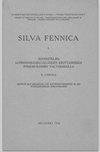Effect of stem rot on wood basic density, carbon, and nitrogen content of living deciduous trees in hemiboreal forests
IF 1.7
3区 农林科学
Q2 FORESTRY
引用次数: 0
Abstract
While numerous studies have focused on analyzing various aspects of the carbon (C) budget in forests, there appears to be a lack of comprehensive assessments specifically addressing the impact of stem rot on the C budget of broadleaf tree species, especially in old-growth forests where stem rot is prevalent. One of the main challenges in accurately quantifying C losses caused by stem rot is the lack of precise data on the basic density and C content of decayed wood, which are crucial for converting decayed wood volume into biomass and C stocks. Using linear mixed-effects models, we examine the variability of wood basic density, C content, and nitrogen (N) content. Discolored and decomposed wood was collected from the stems of 136 living deciduous trees common in hemiboreal forests in Latvia. Our research indicates a noticeable reduction in the wood basic density, coupled with an increase in the N content within the stem wood throughout the decomposition process in birch (Betula spp.), European aspen (Populus tremula L.), grey alder (Alnus incana (L.) Moench), and common alder (Alnus glutinosa (L.) Gaertn.). While aspen wood showed a decreasing trend in C content as decay progressed, a pairwise comparison test revealed no significant differences in C content between discolored and decomposed wood for the studied species, unlike the findings for basic density and N content. This study emphasizes the need to account for stem rot in old-growth forest carbon budgets, especially in broadleaf species, and calls for more research on stem rot-induced carbon losses.茎腐病对半北方针叶林活落叶乔木木材基本密度、碳氮含量的影响
虽然许多研究都集中在分析森林中碳(C)收支的各个方面,但似乎缺乏专门针对茎腐病对阔叶树物种碳收支影响的综合评估,特别是在茎腐病普遍存在的原生林中。准确量化茎腐造成的碳损失的主要挑战之一是缺乏腐烂木材的基本密度和碳含量的精确数据,这对于将腐烂木材体积转化为生物量和碳储量至关重要。利用线性混合效应模型,我们研究了木材基本密度、碳含量和氮(N)含量的变化。从拉脱维亚半北方森林中常见的136棵活落叶乔木的茎上收集了变色和腐烂的木材。我们的研究表明,在桦木(Betula spp.)、欧洲白杨(Populus tremula L.)和灰桤木(Alnus incana (L.))的整个分解过程中,木材基本密度显著降低,茎材内N含量增加。桤木(Alnus glutinosa, L.);Gaertn)。随着白杨木材的腐烂,其C含量呈下降趋势,但两两比较表明,与基本密度和N含量不同,不同树种变色和腐烂木材的C含量差异不显著。本研究强调了在原生林碳收支中考虑茎腐的必要性,特别是在阔叶物种中,并呼吁对茎腐引起的碳损失进行更多的研究。
本文章由计算机程序翻译,如有差异,请以英文原文为准。
求助全文
约1分钟内获得全文
求助全文
来源期刊

Silva Fennica
农林科学-林学
CiteScore
3.50
自引率
11.10%
发文量
21
审稿时长
3 months
期刊介绍:
Silva Fennica publishes significant new knowledge on forest sciences. The scope covers research on forestry and forest ecosystems. Silva Fennica aims to increase understanding on forest ecosystems, and sustainable use and conservation of forest resources. Use of forest resources includes all aspects of forestry containing biomass-based and non-timber products, economic and social factors etc.
 求助内容:
求助内容: 应助结果提醒方式:
应助结果提醒方式:


